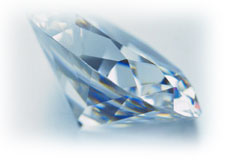Diamond Grading

Diamond color is graded from D-F (colorless) through G-J (near colorless), K-M (faint yellow), N-R (very light yellow) down to S-Z (light yellow). In the K-R range you sometimes get a very light brown called "champagne" and a darker brown called "cognac", both very attractive. Even when a stone has a visible tint, such as an M color, it can still be very lovely if it has good clarity and cut.

Diamonds also come in a wide variety of other colors, including red, blue, green and a bright yellow known as "canary." These are graded as Z+ and are known as fancy diamonds. Ones with good color are very rare and can sell for much more per carat than white diamonds.
It is very common for diamonds to be formed in nature with slight imperfections. These are known as inclusions and can come in many forms, including tiny white points, dark dots of carbon, or feathery cracks. The fewer inclusions, the more the stone is worth. A diamond's clarity ranking is determined by the number, size, type and placement of the inclusions.
It is very common for diamonds to be formed in nature with slight imperfections. These are known as inclusions and can come in many forms, including tiny white points, dark dots of carbon, or feathery cracks. The fewer inclusions, the more the stone is worth. A diamond's clarity ranking is determined by the number, size, type and placement of the inclusions.
The grading ranges from FL
(flawless) through VVS (very, very slight imperfection), VS (very slight imperfection), SI (slight imperfection), I1 (imperfect, can be seen with the naked eye) to I3, commercial or industrial grade. If cut properly a diamond reflects the light back up through the center of the stone to give its characteristic sparkle. A poorly cut stone looks flat like a piece of glass. The quality of the cut is call the "make", and it ranges from Class 1-Ideal Cut (round diamonds only), Class 2-Well Cut, Class 3-Average Cut to Class 4-Below Average Cut.
There are six factors that determine a diamond's class, the most important being table width percentage and depth percentage. They need to be understood because diamond reports give the factors but do not classify them. Most diamonds 1/2 ct and above come with a diamond report from a gem lab. Often they are fancied up and called "certificates" for marketing purposes, but--no matter how important they look--they are just educated opinions from trained gemologists.
(flawless) through VVS (very, very slight imperfection), VS (very slight imperfection), SI (slight imperfection), I1 (imperfect, can be seen with the naked eye) to I3, commercial or industrial grade. If cut properly a diamond reflects the light back up through the center of the stone to give its characteristic sparkle. A poorly cut stone looks flat like a piece of glass. The quality of the cut is call the "make", and it ranges from Class 1-Ideal Cut (round diamonds only), Class 2-Well Cut, Class 3-Average Cut to Class 4-Below Average Cut.
There are six factors that determine a diamond's class, the most important being table width percentage and depth percentage. They need to be understood because diamond reports give the factors but do not classify them. Most diamonds 1/2 ct and above come with a diamond report from a gem lab. Often they are fancied up and called "certificates" for marketing purposes, but--no matter how important they look--they are just educated opinions from trained gemologists.

